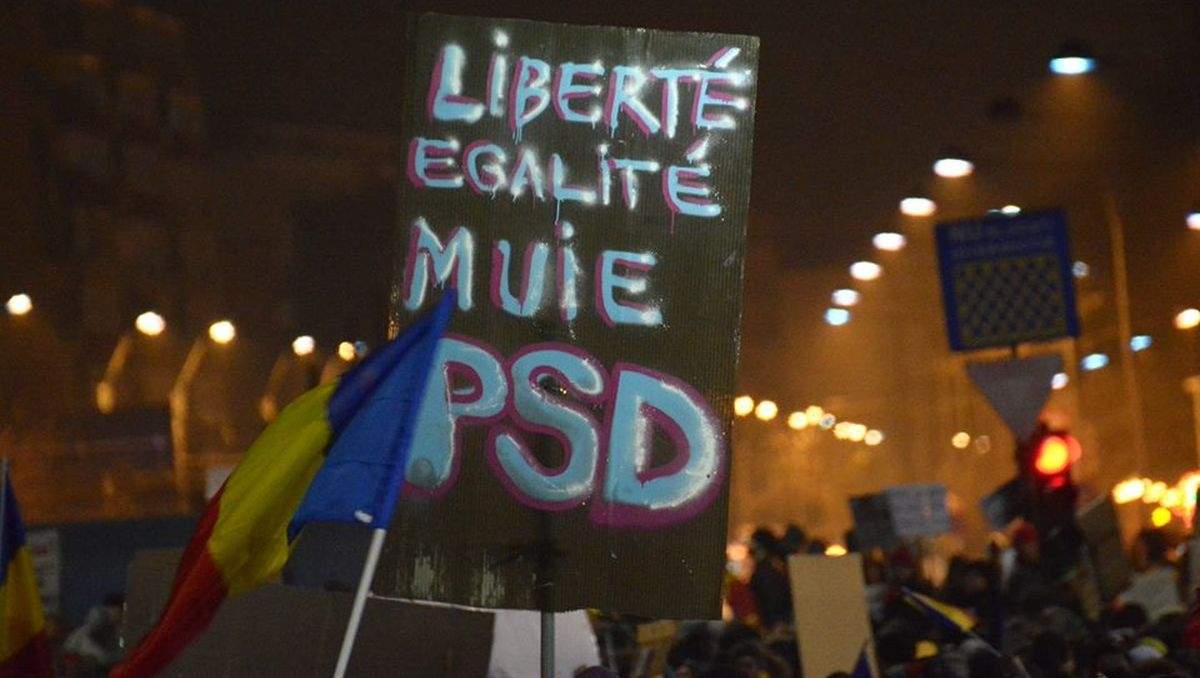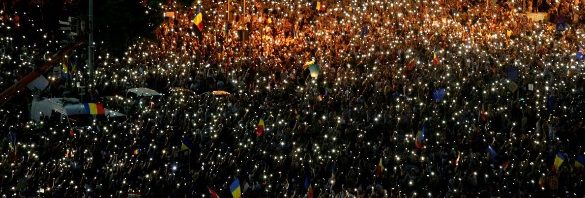Romania came into worldwide attention again recently. On August 10, an 80,000-strong protest against the current ruling coalition and its perceived policies to curb anti-corruption turned violent. The police intervened brutally, using tear gas, water canons and truncheons against demonstrators. Close to 500 people requested medical assistance and hundreds more filed complaints against the gendarmes after the protest. Videos and photos of the police brutality did the rounds of the international press and legitimately sparked outcry at home.
To condemn the violence of the police is easy. To pierce the narratives prefacing and surrounding these events is not. Just as it is increasingly difficult to make sense of what is actually going on in Romania. Since the current ruling coalition won elections in November 2016, the country has seen unprecedented levels of political turmoil. Constant street demonstrations against the main party -PSD – is just a part of the story. Contradictory policies and internal fractures inside the ruling party led to the rather bizarre moments when it managed to bring down two of its own prime ministers. At the time of writing, PSD leaders are holding an emergency meeting in which factions openly fight each other and the talk is to bring down, or at least severely cull the members, of the current cabinet. Thus the paradox that the alliance with one of the strongest Parliamentary majority in the post-communist era is also the one constantly mired in crisis.
In order to be able to grasp the current situation in Romania I believe it is necessary to do away first with mainstream interpretations, common places and clichés. It is not that they are simply wrong, partisan or self-serving. They are in fact bordering on the irrational. One of the most dramatic consequences of the current political and social turmoil has been the outright suspension of reason. The society is, or at least appears to be, so blinded by political partisanship – on all sides – that there is no room left for discussions, let alone analyses. One is either with or against something, no middle ground and no nuances. The few voices that resisted the temptation of outright regimentation in one camp or another are outcast as either traitors or simply stupid for failing to rise to the importance of the moment and join the fight.
The adumbration of reason and the abandonment of critical tools, however, are not restricted to locals only. OpenDemocracy run a piece that not only assumed the perspective of the #resist movement (that is, the protesters against PSD) but also managed to offer a caricature of the opposing sides. Similarly, an article in the Guardian dispensed with all precautions and turned into a eulogy of the protesters. It also mystified the reasons the people took to the streets on August 10, by simply inventing demands that the protesters never actually had. Most shockingly, the left-wing magazine Jacobin published a text by a Romanian journalist that rehashed all the narratives and clichés of the right-wing supporters of the protests. Alexandra Ghit balanced the books by offering an exemplary deconstruction in an article for Lefteast.
Why this misunderstanding? Why this impossibility to cut through official narratives for an in-depth investigation? The reasons seems to be the abandonment of what György Lukács called totality: the analysis of social reality as a whole. Put differently, competing narratives about the protests, and about the social situation in Romania more generally, obtrusively tell just one side of the story. They always leave something out.
The Illiberal Allure of Anti-corruption
The narrative of the protesters is deceptively simple and thus easy to empathize with: a struggle against a corrupt party, led by a convicted person that seeks to muzzle anti-corruption efforts for its own benefit. While there might be some ground to support the claim that a revision of the anti-corruption legislation might help some of the leaders of PSD, the uncritical defense of the current anti-corruption campaign is simply untoward. It means to ignore the very nature of this campaign and its immense abuses that reduced it to a political tool. Without retracing the entire history of the anti-corruption campaign in Romania (especially since readers of this website are by now quite familiar with it), it is

worth remembering that it was meant from the very beginning as a tool in the hands of the former president Traian Băsescu in order to fight the political class as such. No one disputes that corruption has been and still is a problem in Romania, (albeit its levels and outreach are more often exaggerated than real) and something had to be done. But the definition of corruption was very narrow and it referred mostly to the actions of politicians and state functionaries (corruption done by capital, especially global firms, was conveniently left out of the investigations). Moreover, during the time in office of President Băsescu, members of PSD were disproportionately targeted by anti-corruption campaigns. The political nature of the of the campaign was fully revealed when, once Băsescu was no longer in power, his own acolytes faced charges and had to step down.
But the problem with anti-corruption is not restricted to its design, which was faulty to begin with. Its long-term effects are more damning. First, anti-corruption managed to strip of credibility the political class as such and to raise suspicion to the political act in itself. Politicians and politics are dirty by nature, they must not be trusted and should always be kept in check. Technocrats and other unelected figures should fill the void and directly administer things for the people.
Secondly, once corruption was declared a matter of state security, the Romanian Information Service (SRI, the secret police) was brought into action and began to play a large part. Recent declassified protocols between SRI and judicial institutions active in the anti-corruption campaign show the frightening extent to which the secret service was involved in all stages of opening a file and gathering information. While not illegal according to legislation that clearly privileges anti-corruption goals rather than democratic rights of individuals, the protocols were nonetheless bordering illegality. This created a powerful consortium between fully autonomized state institutions that lacked any political oversight and public scrutiny and was backed by the Presidency (the incumbent President Iohannis dutifully continued the practices initiated by Băsescu) and parts of public opinion and the media. Abuses of power were, in such a context, inevitable and they materialized in pressing charges against politicians without a shred of evidence. The goal was simply to shame them for the public opinion and force them to step down. Inevitably, in recent months, judges closed down a series of notorious cases for lack of evidence or due to procedural mistakes. Most gravely, the National Directorate for Anti-corruption (DNA) opened a case against the government in February 2017 for passing a governmental decree, which is a blatant breach of duties. This was one of the main reasons the former head of DNA, Kodruta Kovesi, was dismissed from her position earlier this year.

Finally, the design of the anti-corruption campaign and its subsequent abuses that were made possible by the autonomization of the judicial and secret institutions also led to the transformation of unelected officials into sui generis political figures. Kovesi and other similar figures from the judiciary, but also the heads of the SRI, began to play an increasing role in the public sphere and to use their offices in order to intervene into political disputes and to interfere with the work of the parliament. It is customary in Romania, for example, for prosecutors to express opinions about legislation passed by the Parliament. In some cases, there were even strikes against Parliamentary bills. The principle that the parliament expresses the will of the people and is the sole legislator is now contested in Romania not by some dark forces of illiberalism, but by the supporters and promoters of anti-corruption. As Ciprian Șiulea put it, anti-corruption managed to erode even the modest democratic arrangement of post-communism, depriving the state and the society of the tools to prevent the descent into authoritarianism and populism.
Hence, to blindly and uncritically support the anti-corruption struggle is not only to white-wash its abuses or to ignore its faulty character. It is also a form of supporting institutions of force that act in an authoritarian fashion and without proper public and political scrutiny. Ultimately, it is a way to condone the erosion of the slim liberal democratic framework in the name of very abstract (and quite problematic) principles of justice. Right wing populism, illiberal practices and authoritarianism of political leaders that are now the norm in most of Europe and the US are not recent phenomena in Romania. They were already set in place after 2004 under the auspices of anti-corruption.
From the streets to state institutions: facets of politcal conflict
PSD tried to reign in the abuses of anti-corruption and to redesign it in order to bring it under political oversight. This was absolutely needed and, moreover, it was in line with decisions made by the Constitutional Court that already signaled grave unconstitutional aspects in the anti-corruption laws and practices. But as Costi Rogozanu rightly observed, PSD lacked the credibility for such an important and sensitive issue and, most damagingly, lacked the proper cadres to do so. Suspicions about the real intentions of PSD coupled with incredible dim-witted actions of its key members sparked the protests and led to the current incredible levels of resentment towards PSD.
But again, this is only part of the story. The other part of the story is connected to class. Urban protesters in the big 3-4 Romanian cities where the protests were more vibrant resent PSD not only for its anti-corruption stance but also for the social basis it represents: not the poor as it is commonly, but falsely, claimed, but the petit bourgeoisie of the small cities and the state bureaucracy. In short, it is not just PSD leaders that are resented and despised, but also its members and voters. To make things worst, the current leadership of the party and the government members perfectly express the habitus and idiosyncrasies of the provincial petite bourgeois much to the chagrin of the protesters who constantly make a point of mocking them. This inflated even more the anti-PSD stance and contributed to the duration and forcefulness of the protests.
Indeed, PSD has its many ills and since it has been the most important party of the transition it does bear most of the brunt for the current situation in Romania. But to scapegoat it, as the protesters do, is a form of misjudgment. Here we encounter another paradox: while the social and economic policies implemented recently by PSD are highly worthy of criticism, the anti-PSD protests address none of these issues. In fact, the August 10 protest addressed no issue: the protesters naively demanded that the government should step down and PSD should give up power. More tellingly, the protests were

prefaced by a rather surrealist episode in which the vulgar, tasteless and macho slogan ”Muie PSD” (which roughly translates as ”PSD suck dick!”) became the defining slogan of the #resist movement and embraced across the board. This approach is indicative of the opposition and its repertoire. It is not only misguided and rudimentary but it also suits PSD perfectly, allowing the party leaders to excel in the practice of victimization. The apogee was reached a few days after the protests when PSD president Liviu Dragnea went live on television and affirmed that he was the victim of a botched assassination attempt last year. He then insisted with details in a second phone-in intervention. The story is so far fetched that many questioned his psychical state. His intervention failed to divert attention from the issue of police violence as it was intended to do, but managed to bring down another notch the level of reason in the Romanian public sphere. Admittedly, the level of PSD tactics was already very low. The party constantly portrays the protesters as being paid by George Soros (who, like in many places in Central-Eastern Europe and the US, is portrayed as the chief conspirator against the status quo) and labels them simultaneously as anarchists and fascists. Moreover, PSD misconstrued the events on August 10 as an attempt to a coup d’état. Police brutality was justified by PSD as necessary in order to prevent it.
These forms of argumentation and tactics elicited comparisons in the #resist movement between PSD and ruling parties in Hungary, Poland and Turkey. This is even more ridiculous and it shows what the two sides have in common: a race to the bottom towards utmost ridiculousness. In fact, the entire narrative according to which Dragnea and PSD are local embodiments of similar traits found in Hungary, Poland and Turkey should be rejected as utterly baseless. PSD has historically sought to link profoundly the party with the state apparatus and an authoritarian vibe was always constitutive of its operations, but we are still very far from a situation comparable to the aforementioned states. The reason is simple, and it was already sketched above: neither Dragnea, nor PSD (nor any other political actor) has or could muster enough political power and control over the state. After all, Erdogan put some tens of thousands of people in jail without proper trail, Orban changed the constitution five times since 2011, and is planning to implement more amendments, and the governing party in Poland changed the composition of the Supreme Court by one decree – to name just few examples. By contrast, in Romania, PSD faced significant backlash for trying to pass legislation that even the Constitutional Court deemed necessary. The anti-corruption campaign shifted the real place of power from politicians (the Government and the Parliament) to the nexus that links the judiciary with the SRI.

Let me go back briefly to the events on August 10. To stress it once more, the violence of the police and gendarmerie was despicable. But not at all surprising! This is after all a repressive institution, well financed and well manned, that exerted brutal violence in the past as well. In 2012 anti-austerity protesters were savagely beaten on the streets of Bucharest. Many football supporters can testify for the violence of the gendarmes on a weekly basis. The power the gendarmerie enjoys is itself an effect of a wider process: the continuous strengthening in the past decade (if not more) of the repressive institutions of the state. The police, the gendarmerie, the Army, the secret services, all benefit from generous state budgets, special pensions and in general a special treatment compared to other state institutions.
More alarmingly, on August 10 not only police brutality raised questions, but also the erratic, inconsistent and amateurish manner in which the intervention of the gendarmes unfolded. The investigation that followed did nothing to clear the air. A series of contradictions between state officials and a number of inadvertences between their declarations led to a blame game that raised even more suspicions. The gendarmerie appeared in disarray and the leadership clueless. The head of the Minister of Interior appeared equally overrun by the situation and out of synch with her subordinates and other related institutions.
When lacking proper information, which is notoriously hard to get in such cases, there is always the trap of undue speculation. But, in accordance with the mood in Romania, let me offer mine: what happened on August 10 – and I refer here to the very violent but also extremely chaotic and suspiciously sloppy intervention of the police – is in fact a symptom of a larger problem. At first glance and according to all mainstream narrative what we seem to witness in Romania is a struggle between righteous demonstrators and a vile PSD around, or starting from, the anti-corruption issue. My suggestion is different: what really takes place is a very concrete power struggle between various branches and structures of autonomous state institutions that seek to preserve or enhance their power share, not different from the cases described by Nicos Poulantzas. SRI and the judiciary institutions that have the most to lose following a more pronounced assertion of political control are, naturally, expected to be the most active in this struggle. After all, the protests on August 10 had no official organizers or leaders – an impressive feature for an 80,000 people gathering.
This type of interpretation might border on the conspiracy theory. But precisely because of that might also be the most rational in the current context.

